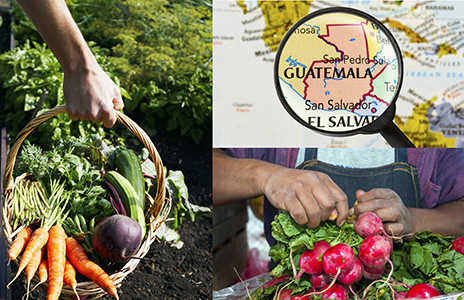Evaluating a Family-Based Nutrition and Garden Intervention in Rural Guatemala Pilot Study
 Study Overview
Study Overview
This mixed methods pilot study study evaluated the feasibility and potential effectiveness of adding a home garden to an existing local standard of nutrition care for children with chronic malnutrition (stunting) in rural Guatemala. Families of 70 children received a home garden intervention that included garden materials, monthly agricultural home visits, and agriculture classes. Both nutrition outcomes (maternal and child dietary diversity, household food insecurity, child growth, agricultural indicators) and implementation outcomes (evaluated through a RE-AIM framework) were included. This study was a collaboration between the Academy of Nutrition and Dietetics and Wuqu' Kawoq/Maya Health Alliance — a non-profit organization providing health and nutrition services to indigenous communities in Guatemala — and was supported by funding from the Academy of Nutrition and Dietetics Foundation and Rotary International.
Published Outcomes
Abstract: Home gardens may help address childhood malnutrition in low- and middle-income countries. In this quasi-experimental pilot study, the Academy of Nutrition and Dietetics, in collaboration with Maya Health Alliance, evaluated the feasibility of augmenting a standard of care nutrition-specific package for Maya children with length-for-age z score ≤–2 (stunting) in rural Guatemala with a nutrition-sensitive home garden intervention. Two agrarian municipalities in Guatemala were included. Families of 70 children with stunting from 1 municipality received the standard-of-care package (food supplementation, multiple micronutrient powders, monthly nutrition home visits, group nutrition classes). Families of 70 children with stunting from another municipality received the standard-of-care package plus a home garden intervention (garden materials, monthly agricultural home visits, agriculture classes). Maternal and child dietary diversity, household food insecurity, child growth, and agricultural indicators were collected at baseline and 6 months later and were analyzed using mixed linear and logistic regression models. Compared with the standard-of-care group, the garden intervention group had improved child (odds ratio [OR] 3.66, 95% CI 0.89-15.10, P = 0.07) and maternal dietary diversity (OR 2.31, 95% CI 0.80- 6.65, P = 0.12) and decreased food insecurity (OR 0.38, 95% CI 0.11-1.35, P = 0.14); however, these effects were not statistically significant. Participation in gardens predicted a higher length-for-age z-score (change difference [CD] 0.22 SD, 95% CI 0.05-0.38, P = 0.009), greater crop species count (CD 2.97 crops, 95% CI 1.79-4.16, P < 0.001), and greater nutritional functional diversity (CD 0.04 points, 95% CI 0.01- 0.07, P = 0.006) than standard-of-care alone. Home garden interventions are feasible in rural Guatemala and may have potential benefits for child growth when added to other nutrition-specific interventions.
Abstract:
Background -Home gardening is a strategy to improve nutrition and food security. More information is needed about optimizing gardens in different contexts.
Objective -The aim was to identify implementation barriers and facilitators for a home gardening intervention in rural Guatemala and inform future larger-scale interventions in the region.
Design - A mixed-methods implementation study using the RE-AIM (Reach, Effectiveness, Adoption, Implementation, Maintenance) framework was conducted from January 2019 to July 2020.
Participants/setting - Families (n ¼ 70) in rural Guatemala participated in the intervention. Staff (n ¼ 4), families (n ¼ 6), and community stakeholders (n ¼ 3) participated in interviews or focus groups.
Intervention - Participating households received seeds and seedlings for 16 crops, garden construction materials, agronomist-delivered education and assistance, and a standard-of-care nutrition program.
Main outcome measures - Implementation data were collected from program records and observations, participant surveys, and interviews and focus groups. Crop count and nutritional functional diversity of home gardens were assessed.
Statistical analyses performed - Descriptive statistics were calculated for quantitative outcomes. Qualitative data were double-coded and organized into overarching themes.
Results-
Reach - Ninety percent of eligible households participated. Child nutritional eligibility criteria was a barrier to reach.Effectiveness: Participants and stakeholders felt the intervention improved access to diverse foods. Cultivated crops increased an average of five species (95% confidence interval [CI], 4e6) at 6 months, although not all were consumed.
Adoption - The main community adoption barrier was water sourcing for garden irrigation. Implementation: Raised beds were the most common gardening method, with good adoption of agricultural best practices. Gray water filters and flexible implementation were important for participation.
Maintenance - Crops failure rates were low. Seed availability was a sustainability challenge. Direct costs were 763 USD per household.
Conclusions - Interest and engagement with a home garden intervention in Guatemala were high. Gaps between garden production and consumption, access to water, and seed sourcing should be addressed in future work.
Additional Dissemination Activities
- Educational Sessions at the Food & Nutrition Conference & Expo® 2018 and 2020
- Newsletter article “Designing an intervention to improve nutrition in rural Guatemala through home gardens” published in LAHIDAN Spring 2019 newsletter
- HEN DPG webinar (“Overcoming challenges in a home gardening program for child malnutrition in rural Guatemala”) presented in May 2019
- LAHIDAN MIG webinar "Contextualizing Nutrition-Sensitive Agricultural Programming" presented in September 2019
- Paper describing formative work for study published in Estudios Sociales (doi: https://doi.org/10.24836/es.v30i55.935)
- Poster presentation at ASN Nutrition 2022
References
Join the Academy
Members of the Academy of Nutrition and Dietetics receive exciting benefits including complimentary continuing professional education opportunities, discounts on events and products in eatrightSTORE.org, invitations to exclusive members-only events and more!
